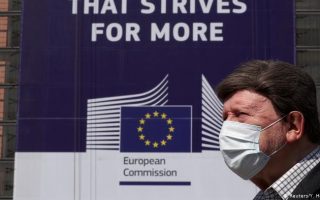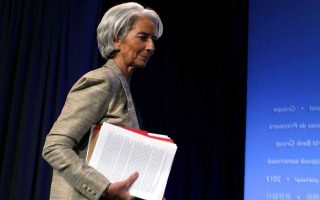European economy: What’s next?

According to Thucydides, “it was the rise of Athens and the fear this instilled in Sparta that made war inevitable.” Over the past 500 years there have been 16 cases in which a rising power threatened to displace a ruling one; 12 of these ended in war. It is not implied, of course, that the clash between US and China will result in a war, even if the underlying definition is a multifaceted one. But there is an ongoing global trade war. And globalization was already in reverse before Covid-19. The 2008 financial crisis undermined the faith of Western voters in the free market capitalist system. The latent impact continued with Brexit, the rise of Donald Trump and the US-China trade war. The virus is just accelerating the anti-globalization trend. After all, the political debate will turn to how to pay for the lockdown support measures and how to address the inequalities that have been worsened by the pandemic.
The global health crisis forced most governments to lock down everything, affecting economic activity and causing financial markets to revalue lower at an unprecedented pace. Policymakers responded with massive monetary and fiscal support measures. And one huge oxymoron – asset prices appear disconnected from the real economy. The distribution of potential economic scenarios over the next 12 months is very broad. Will there be a V-shaped recovery? Or will a second virus wave further harm economic activity? Many scenarios may be considered. Under the optimistic one, the rapid development of a medical treatment for the virus would enable economies to reopen and normalize more quickly. The pessimistic scenario entails a strong and aggressive second wave of the virus that could lead to a deep recession and result in permanent business closures and job losses. The baseline scenario is associated with a gradual improvement in economic data, but with many negatively skewed risks.
In Europe, mediocre growth is expected over the next five years. However, a recession in the US would probably be contagious. Europe does have a significant current account surplus, which provides flexibility in the event of a slowdown. The problem of Europe is that there’s no consensus among governments about when deficit spending is desirable or should be allowed. There’s no doubt that Europe was initially slow in launching policy measures to combat the coronavirus shock. But now there are many reasons to be optimistic about the euro area in the second half of 2020. An impressive array of fiscal and monetary measures is being put into place to bridge the economy through the shock. The European Central Bank has launched new and flexible quantitative easing – i.e. the pandemic emergency purchase program. Its targeted longer-term refinancing operations scheme holds the promise to provide support to the private sector via cheap loans to banks. The ECB has also made clear that it is ready to do more in monetary policy stimulus, if the inflation outlook doesn’t show sufficient progress toward price stability. The recovery fund will deliver critical savings for EU countries that otherwise would have to pay higher yields on their lower-rated sovereign bonds compared to the triple-A rated EU paper. This is an important step to further fiscal integration within the EU and could be considered a historic milestone. The question for investors now is whether such support can continue to offset a sharp fall in corporate profits.
Taking a closer look at the European case, it can be stressed that European economies are gradually emerging from lockdown, but the economic cost has been high, with the Organization for Economic Cooperation and Development forecasting a eurozone GDP decline of 9.1% in 2020, followed by a 6.5% rebound in 2021. Europe’s disadvantage at the beginning of the Covid-19 crisis was its lack of policy ammunition. The ECB policy rate was already negative, there were strict rules around increasing fiscal deficits and high-debt countries were at risk of a rerun of the 2012 debt crisis. However, the policy response has surprised on the upside. The ECB increased its asset-purchase program by more than 12% of GDP. Rules on fiscal deficits have been temporarily relaxed, resulting in fiscal stimulus of around 3.5% of GDP across the region.
The deal on the recovery fund reached by European leaders is not ideal, but it is a deal, nonetheless; it opens the road to greater EU integration. After hard negotiations, the European Council announced a deal on a specific recovery plan. The agreement maintains the €750 billion (5.5% of 2019 EU GDP) fund proposed in May; however, the allocation between grants and loans has been changed in favor of loans, given the resistance of the Netherlands, Austria, Denmark and Sweden. The final version will consist of €390 billion in grants (instead of €500 billion) and €360 billion in loans (instead of €250 billion). And countries requesting funds will have to submit a recovery and resilience strategic plan for approval by a majority and not by unanimity as Dutch Prime Minister Mark Rutte suggested.
More than six months into the Covid-19 pandemic, the number of cases has topped 10 million worldwide and the global economy has been hit hard by numerous shutdowns to contain the spread of the disease. The virus outbreak is one of the most financially destructive events of the past 120 years, a period that includes two world wars, the Great Depression and the Global Financial Crisis. Market participants define the pandemic crisis as the 21st century’s first sustainability crisis and one that has renewed the focus on climate change, acting as a wake-up call for decision makers to prioritize a more sustainable investment approach, that will also consider climate change.
The Covid-19 crisis drove the global economy into an unprecedented freeze in the first half of 2020. In Europe, the budgetary process and recovery plan mentioned might redesign the future of the union, toward more sustainable and equal growth. What’s to come? No one can say with certainty. The bursting of the dot-com bubble foretold a 10-year bear market for the technology sector. And 10 years after the global financial crisis, the banking sector hadn’t fully recovered. Huge implications and changes are expected after this crisis. But, for sure, the world is not likely to return soon to where it was in January of 2020.
Panos Xidonas is a full professor of finance at ESSCA École de Management in Paris. Manthos Delis is a professor of financial economics and banking at Montpellier Business School.





